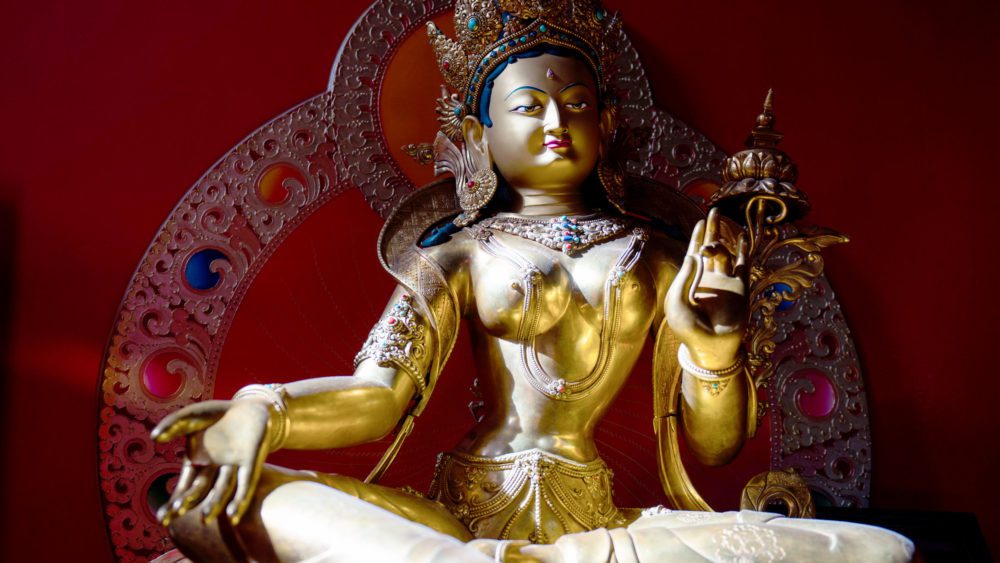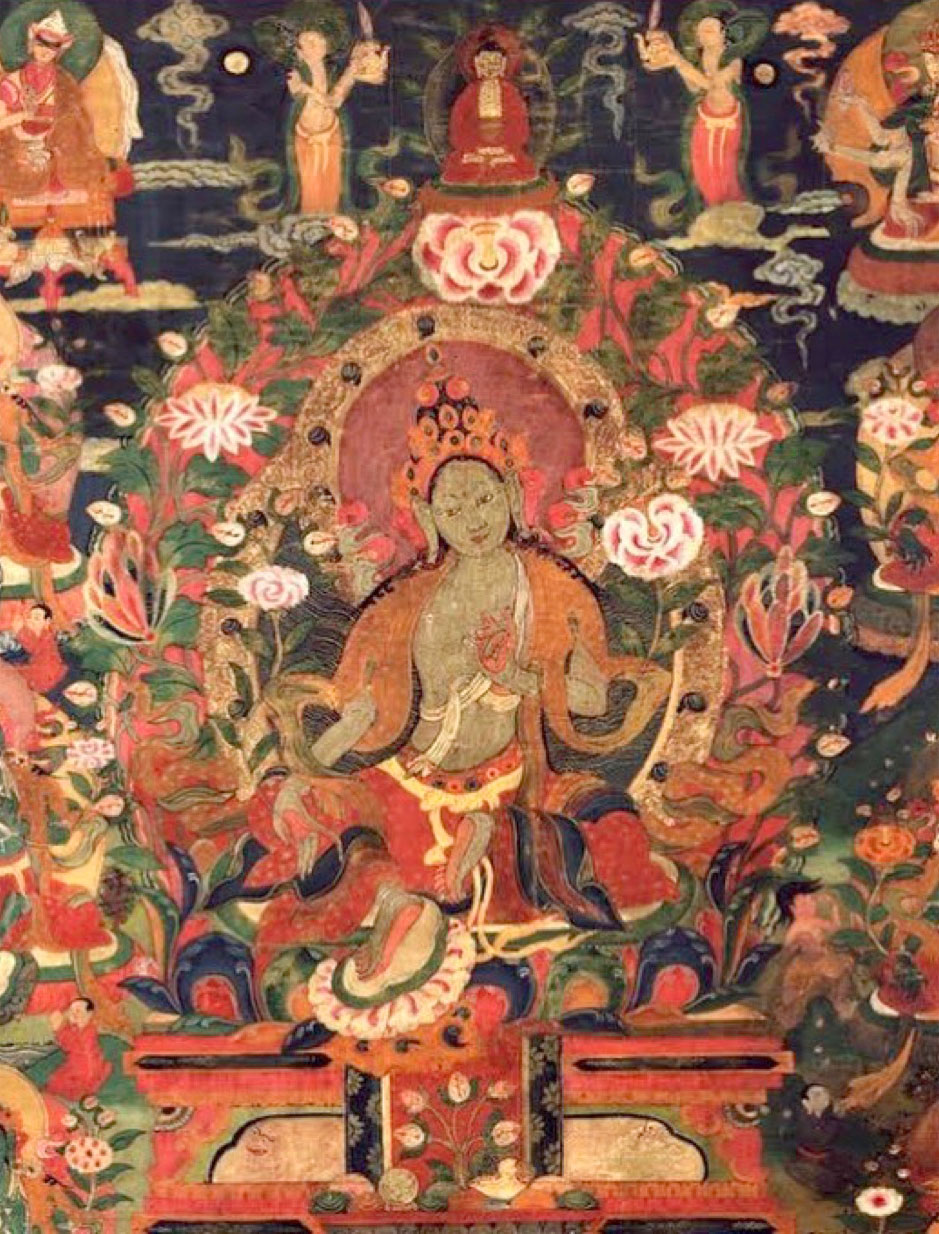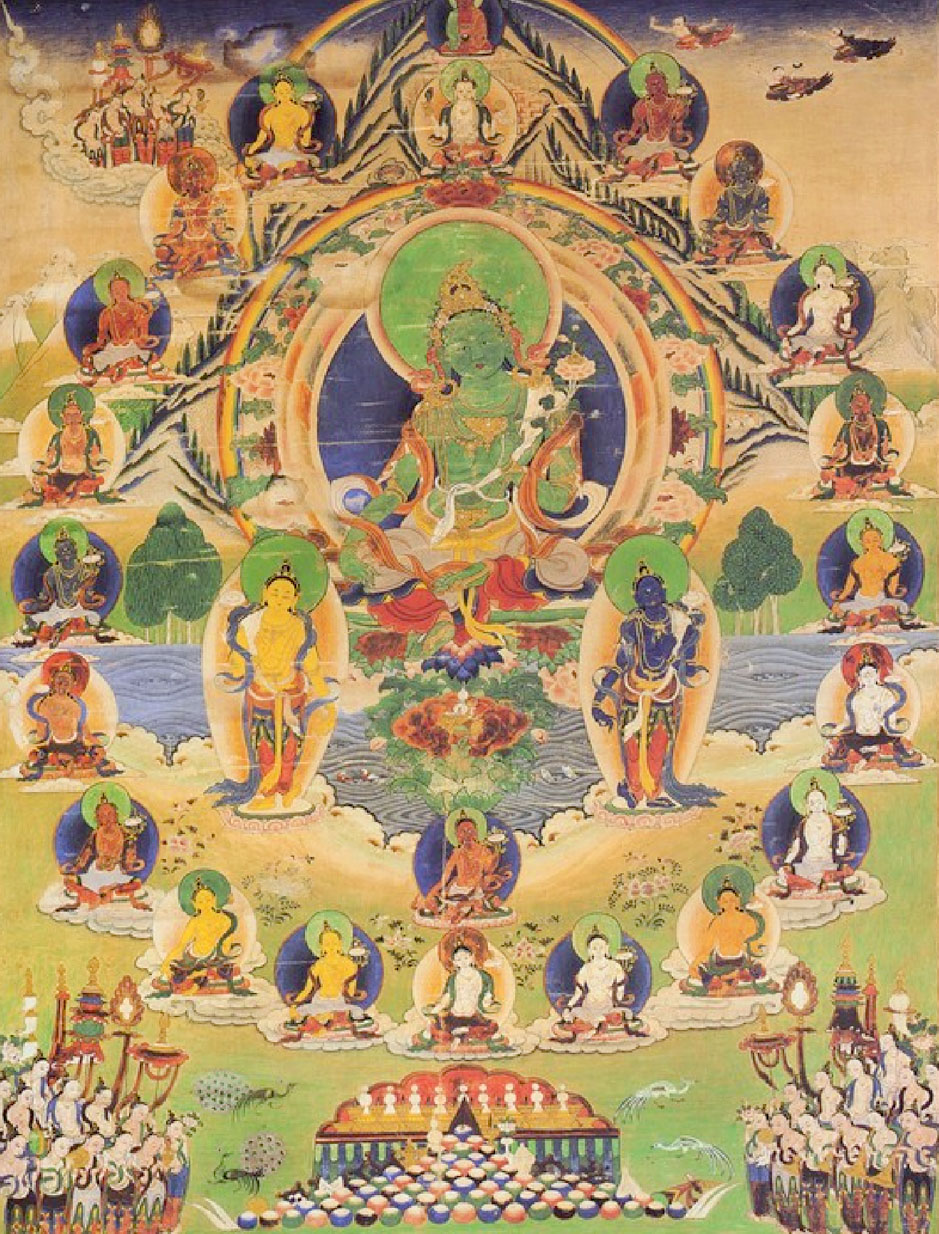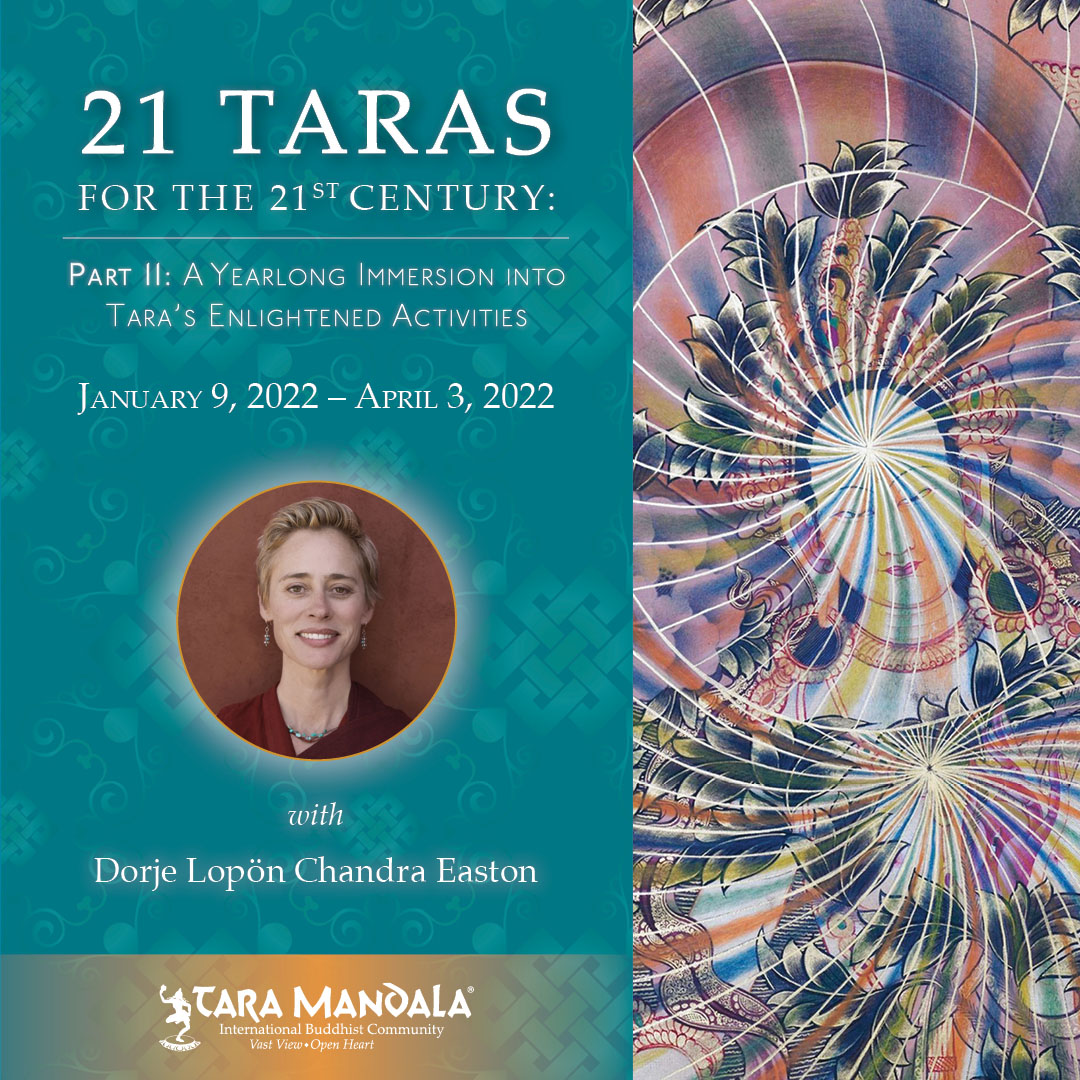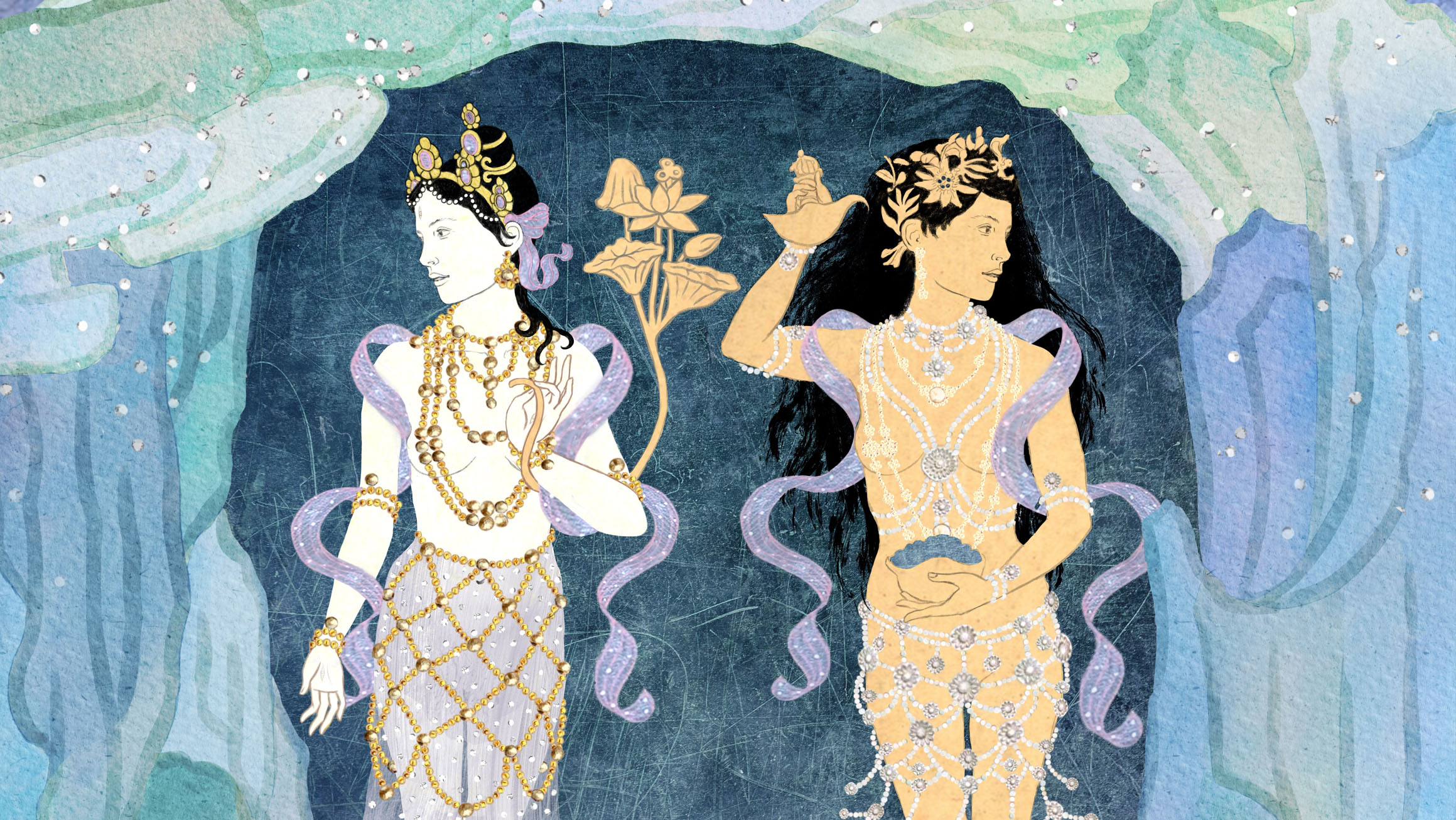“Tārā is you at your most essential inner core … she is your own enlightened mind, the union of bliss and emptiness.” ~ Dorje Lopön Chandra Easton
Like us, Tārā is many things all at once. All names and descriptions are like fingers pointing at the moon, or star in this case because one of the meanings of Tārā is star. All these names are not the actual Tārā because the actual Tārā is beyond label or concept. Still, one could say Tārā is the nonconceptual nature of your own pristine awareness (Tib. rigpa, Skt. vidyā). So why should we even try to define her? We do so, like with everything in this world, by naming something we help to bring it into being, we bring it into the foreground of our experience. We give her names and epithets so that we can honor and understand her, write poetry to her, meditate on her, chant mantras to her, so that we may find meaning in our lives and traverse the ocean of our own suffering. Thus, we can understand Tārā in the following ways…
● Tārā is a legendary princess who became a Bodhisattva, one who commits to liberation for the benefit of all;
● Tārā is a fully awakened Buddha abiding in her heavenly realm called Potala;
● Tārā is the mother of all Buddhas, called Yum Chenmo in Tibetan which means the Great Mother, sometimes synonymous with Prajnaparamita;
● Tārā is a tantric deity, who bestows blessings and invites us to merge our consciousness with her, and to recognize that she is us, we are her.
● Tārā is the wisdom ḍākiṇī, the ultimate nature of mind as expressed by the fierce divine power
● Tārā’s enlightened activities (Tib. trinlé) are limitless but have become most well known as the 21 aspects of Tārā in her many forms;
● Tārā is you at your most essential inner core, beyond individual identity of your sex, gender, name and form, she is your own enlightened mind, the union of bliss and emptiness.
Miranda Shaw, in her book, Buddhist Goddesses, sums up this question succinctly…
“Ethereal yet regal, delicate yet majestic, Tara exudes supreme confidence that she can answer every prayer and fulfill any need. She sends forth countless manifestations in every color of the rainbow, displaying infinite nuances of liberating power, filling the universe with her nectar of mercy, enveloping living beings in the mantle of her maternal grace. At once a transcendent Buddha queen and tender mother, Tara is without doubt the most beloved goddess of the Indo-Tibetan pantheon.” (pg. 307)
The name Tārā means “she who helps to cross to the other shore” meaning that she has the power to help beings traverse the ocean of suffering, saṃsāra, to the far shore of liberation, nirvaṇā. Thus, she is called the “Savioress.” Her name also means “Star”, as in the star that shows us the way, like the North star guides us in our journey, metaphorically the light of our internal North star guides us to the light of our true nature.
One of Tārā’s origin myths tells the story that eons ago, in another world system, Tārā was a princess named Wisdom Moon who, through her devotion, became a Buddha and thus earned the name Tārā, the Saviouress. Another popular origin story says that later, Tārā appeared in another eon called “Without Beginning” and arose from the heart (some stories say teardrop) of the deity Avalokiteśvara (Tib. Chenrezig), the male Buddha of Compassion. In this myth, she is referred to as the Daughter of Avalokiteśvara, and is said to have benefited innumerable beings through her blessings.
Tārā is primarily known for saving beings from fear and misfortune, and on the most subtle level, which we explore below, she is the ultimate nature of our own minds. But her powers are said to be based on the force of our devotion and trust which opens us to her compassion. Bokar Rinpoche, in Tara the Feminine Divine, explains it this way:
“Tārā has the power to help us. However, this power is effective only if we trust it. For Tārā to help, we must pray to her and call upon her from the bottom of our hearts without reserve or doubting her intervention. The deity’s response depends on the strength of our trust. If doubt inhabits our mind, there is a small probability that Tārā’s blessing and protection will come to us, whereas a trust without reserve and a complete conviction, will ensure that they will certainly come.” (pg. 23)
He continues,
“In reality, all worldly appearances are a manifestation of our mind. Fear, apprehension, and danger are also a manifestation of our mind, just like a bad dream the mind creates both the threat and the one who feels it.
The creative faculty of our mind is very strong. It is this strength that exerts itself in the fervent prayer addressed to Tārā. Together with Tārā’s immense will to help beings, this strength makes possible the protection. The help that we receive is the fruit of the meeting of these two factors, the force of our devotion and Tārā’s compassion.” (pg. 24)
Photo: Rubin Museum Of Art
In essence, he explains that because all phenomena are impermanent and lack intrinsic existence — that phenomena have no reality in themselves — they are empty in nature. This is called “emptiness” (Skt. śūnyatā) and is an important teaching first taught by the Buddha and then elucidated in the Prajñā Pāramitā Sūtras which ushered in the Mahāyana era of Buddhism around the turn of the millennium. Bokar Rinpoche explains that it is due to this interdependent, empty nature that change is possible, life and death occur, for if that were not the case, phenomena would be locked in some strange form of permanence and solidity, if there is no change, then birth and death, for example, would be impossible. He explains that because our perceptions (thoughts, feelings, emotions, all appearances) are expressions of the deep conditioning of our own mind, they are interdependent, arising due to causes and conditions, and because of that, this deep conditioning can be changed. It is this malleability and interdependence that makes prayer, trust, and devotion intertwined with our capacity to receive and experience Tara’s vast compassion.
Tārā is a Buddha, fully awake, meaning she awoke from the slumber of ignorance that kept her separated from her true nature, true power, true potential. All of us, in some way or another, can identify with Tara’s story of liberation. Where are we asleep in our life? How have we overcome hardships to manifest our potential in this life? We may see ourselves in these Tara archetypes as well as the real-life women I will highlight in the “21 Taras for the 21st Century” online course.
21 Tārās for the 21st Century
January 9 – April 3, 2022
In this transformational study program, Dorje Lopön Chandra Easton, Buddhist teacher, scholar, and Tārā Mandala’s Assistant Spiritual Director, reveals the 21 aspects of Tārā, the female Buddha of Compassion.
This course is part two of a three part series, but it is suitable for those joining for the first time, as well as for those who participated in the previous 21 Tārā’s courses and all who have a desire to go deeper into their study of Tara’s enlightened activity. All are welcome. This session is a stand-alone study of Taras 8-14 and you do not need to have received the teachings in Part 1 to participate.
Through powerful and inspiring stories about real women, both historic and modern, Buddhist and non Buddhist, you will gain knowledge and personal experience about the myriad qualities of these 21 Tārās. You will have the opportunity to become immersed in the world of Tārā through study, practice, and connection with others on this path … Read more »
ABOUT DORJE LOPÖN CHANDRA EASTON
Dorje Lopön Chandra Easton, Buddhist teacher and translator, studied Buddhism and Tibetan language at the Library of Tibetan Works & Archives in Dharamsala, India, founded by H.H. Dalai Lama. She later received her degree from UCSB’s religious studies department at which time she co-translated Sublime Dharma, A Compilation of Two Texts on the Great Perfection, published by Vimala Publishing, 2012. From the very beginning of her Buddhist studies, Dorje Lopön Chandra recognized the profound need to bring forth the voice of the sacred feminine in Buddhist theory and practice. Due to this, in 1999 during her first pregnancy, she met and then later began to study with Lama Tsultrim Allione, pioneering female Buddhist teacher, national best selling author, and founder of Tara Mandala Retreat Center. Dorje Lopön Chandra is the Assistant Spiritual Director and Lead Senior Teacher at Tara Mandala Retreat Center. She serves on the Tara Mandala Board of Trustees, develops programs and curricula for Tara Mandala, as well as teaches nationally and internationally … Read more »
We hope you can join us, to invite Tārā into your life, find enrichment in her blessings, and enjoy the nourishment of compassion.
~With Blessings,
Tara Mandala

